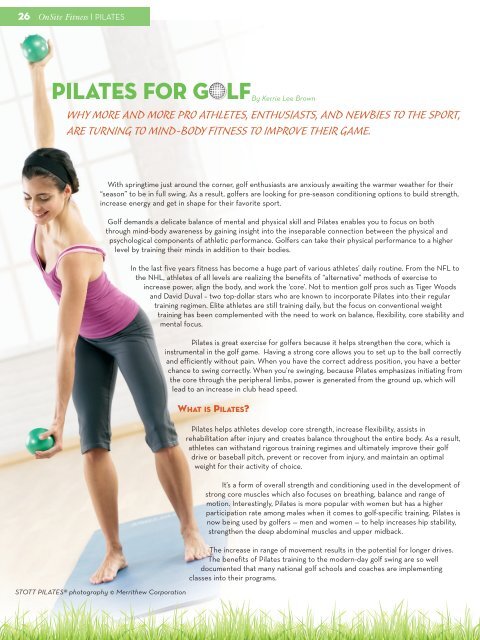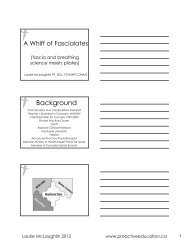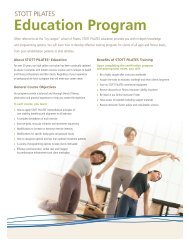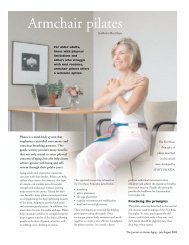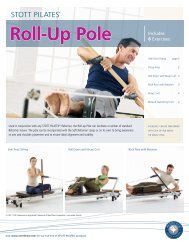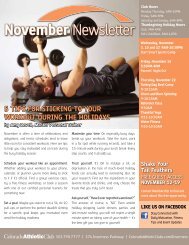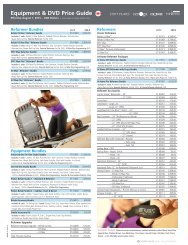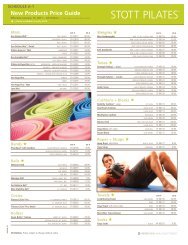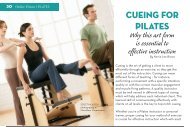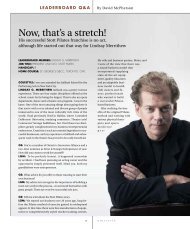PILATES FOR GOLF - Pilates Fitness
PILATES FOR GOLF - Pilates Fitness
PILATES FOR GOLF - Pilates Fitness
You also want an ePaper? Increase the reach of your titles
YUMPU automatically turns print PDFs into web optimized ePapers that Google loves.
26 OnSite <strong>Fitness</strong> | <strong>PILATES</strong><br />
<strong>PILATES</strong> <strong>FOR</strong> <strong>GOLF</strong> By Kerrie Lee Brown<br />
WHY MORE AND MORE PRO ATHLETES, ENTHUSIASTS, AND NEWBIES TO THE SPORT,<br />
ARE TURNING TO MIND-BODY FITNESS TO IMPROVE THEIR GAME.<br />
With springtime just around the corner, golf enthusiasts are anxiously awaiting the warmer weather for their<br />
“season” to be in full swing. As a result, golfers are looking for pre-season conditioning options to build strength,<br />
increase energy and get in shape for their favorite sport.<br />
STOTT <strong>PILATES</strong>® photography © Merrithew Corporation<br />
Golf demands a delicate balance of mental and physical skill and <strong>Pilates</strong> enables you to focus on both<br />
through mind-body awareness by gaining insight into the inseparable connection between the physical and<br />
psychological components of athletic performance. Golfers can take their physical performance to a higher<br />
level by training their minds in addition to their bodies.<br />
In the last five years fitness has become a huge part of various athletes’ daily routine. From the NFL to<br />
the NHL, athletes of all levels are realizing the benefits of “alternative” methods of exercise to<br />
increase power, align the body, and work the ‘core’. Not to mention golf pros such as Tiger Woods<br />
and David Duval – two top-dollar stars who are known to incorporate <strong>Pilates</strong> into their regular<br />
training regimen. Elite athletes are still training daily, but the focus on conventional weight<br />
training has been complemented with the need to work on balance, flexibility, core stability and<br />
mental focus.<br />
<strong>Pilates</strong> is great exercise for golfers because it helps strengthen the core, which is<br />
instrumental in the golf game. Having a strong core allows you to set up to the ball correctly<br />
and efficiently without pain. When you have the correct address position, you have a better<br />
chance to swing correctly. When you’re swinging, because <strong>Pilates</strong> emphasizes initiating from<br />
the core through the peripheral limbs, power is generated from the ground up, which will<br />
lead to an increase in club head speed.<br />
WHAT IS <strong>PILATES</strong><br />
<strong>Pilates</strong> helps athletes develop core strength, increase flexibility, assists in<br />
rehabilitation after injury and creates balance throughout the entire body. As a result,<br />
athletes can withstand rigorous training regimes and ultimately improve their golf<br />
drive or baseball pitch, prevent or recover from injury, and maintain an optimal<br />
weight for their activity of choice.<br />
It’s a form of overall strength and conditioning used in the development of<br />
strong core muscles which also focuses on breathing, balance and range of<br />
motion. Interestingly, <strong>Pilates</strong> is more popular with women but has a higher<br />
participation rate among males when it comes to golf-specific training. <strong>Pilates</strong> is<br />
now being used by golfers — men and women — to help increases hip stability,<br />
strengthen the deep abdominal muscles and upper midback.<br />
The increase in range of movement results in the potential for longer drives.<br />
The benefits of <strong>Pilates</strong> training to the modern-day golf swing are so well<br />
documented that many national golf schools and coaches are implementing<br />
classes into their programs.
<strong>PILATES</strong> | OnSite <strong>Fitness</strong> | www.onsite-fitness.com 27<br />
BENEFITS <strong>FOR</strong> ATHLETES<br />
Overall, <strong>Pilates</strong> is a key component to athletic conditioning<br />
because it focuses on the deeper muscle groups, or “local”<br />
stabilizers. These are key in controlling joint movement and in<br />
sustaining the stability of the joints that can often be damaged<br />
through repetitive and high demand training. As well, the physical<br />
awareness that the athlete gains through a strong <strong>Pilates</strong> program<br />
can aid in their movement control enabling them to increase their<br />
level of performance.<br />
<strong>Pilates</strong> works on developing kinesthetic awareness of the body, or<br />
where it is in relationship to itself, and the world around it. It also<br />
focuses on good postural alignment which will help an individual<br />
perform a movement efficiently, thus reducing the amount of<br />
unnecessary strain on the muscles and joints. Specific strengthening<br />
exercises will also help to balance the muscles around a joint and<br />
balance pairs of muscles that support the joints.<br />
Many clients say when they take <strong>Pilates</strong> they start to think about<br />
their body and its function differently. In particular, they start<br />
thinking about their ‘center’ or the ‘core’. Ultimately they find that<br />
they transfer all that they learn in the studio to the playing field –<br />
often subconsciously. Whether cyclists, golfers, rugby players –<br />
clients find they have more power after taking <strong>Pilates</strong>.<br />
In general, athletes are good at what they do, and since <strong>Pilates</strong> is<br />
often a foreign activity for them, they are forced to think about<br />
what they are doing physically and mentally. It’s not like a cyclist<br />
doing a Spinning class. <strong>Pilates</strong> makes athletes get back in touch with<br />
their basic training principles and therefore expands on what they<br />
already know. The benefits are amazing – increased power, strength<br />
and mobility.<br />
can be beneficial in assisting overall flexibility in tighter regions<br />
(lower back, hamstrings, shoulders) and this can aid in creating a<br />
stronger game and a greater level of stamina on the course. Finally,<br />
the emphasis on breath as one of the principles can aid a golfer to<br />
focus on their game, relax through their swing and control precise<br />
movements such as those needed in putting. <strong>Pilates</strong> helps improve<br />
overall co-ordination of biomechanics, flexibility, and core strength,<br />
therefore decreasing the chances of injury.<br />
<strong>PILATES</strong> <strong>FOR</strong> THE AVID <strong>GOLF</strong>ER<br />
For the most part, golf and <strong>Pilates</strong> share the same basic<br />
principles, requiring flexibility, rotation and core and gluteal<br />
strength. For golfers looking to stay healthy on the greens, <strong>Pilates</strong> is<br />
the ideal golfing partner. While the golf-pro may help correct swings<br />
and take strokes off a player’s game, the <strong>Pilates</strong> specialist can<br />
improve a golfer’s performance, stamina and stability. These<br />
changes can help clients drive the ball farther and avoid the<br />
sand-trap of fatigue and injury.<br />
Try to get your <strong>Pilates</strong> students involved in some type of exercise<br />
and stretching before hitting the green. <strong>Pilates</strong> is one of the most<br />
popular forms of exercise for golfers right now and they will see a<br />
huge improvement in their game through its practice.<br />
For more information on <strong>Pilates</strong> for Golf Conditioning, visit<br />
www.stottpilates.com<br />
Kerrie Lee Brown is Vice President of Communications<br />
for STOTT <strong>PILATES</strong>®<br />
OSF<br />
<strong>PILATES</strong> <strong>FOR</strong> PREVENTION OF INJURY<br />
In golf, players compete against gravity in a three-dimensional,<br />
unstable environment. In order to prevent injuries and improve<br />
swings, the exercises in a well-designed fitness program must<br />
directly enhance the golfers’ ability to keep their center of gravity<br />
(upper body) aligned over their base of support (feet and legs).<br />
Machine-based fitness programs — which function by strengthening<br />
muscles in isolation — do not contribute significantly to improved<br />
athletic function. When you swing a club, the brain recruits groups<br />
of muscles, coordinating them in unique sequences like a conductor<br />
leading an orchestra. Integrated <strong>Pilates</strong> training parallels how the<br />
body functions when playing a sport.<br />
<strong>Pilates</strong> is particularly effective for recovering from injury. It<br />
teaches athletes to be mindful in their movements – integrating<br />
their pelvis, trunk and shoulder girdle in a safe, challenging and<br />
progressive system. <strong>Pilates</strong> can be a very effective supplement to<br />
an injury rehabilitation program as it provides athletes with a<br />
challenging workout without impact or excessive weight bearing.<br />
The exercises in a <strong>Pilates</strong> workout aid in developing core strength<br />
particularly in the trunk muscles. Additionally, because the exercises<br />
focus on deeper muscles, <strong>Pilates</strong> can assist with injury prevention.<br />
Because <strong>Pilates</strong> works on a controlled lengthening of the muscles, it<br />
STOTT <strong>PILATES</strong>®<br />
photography © Merrithew Corporation


